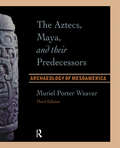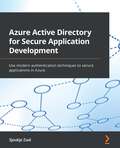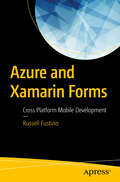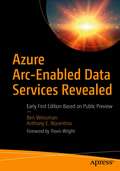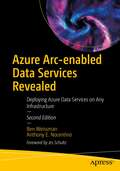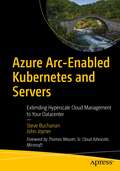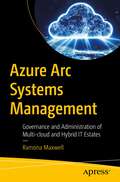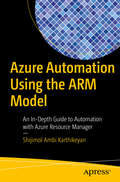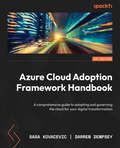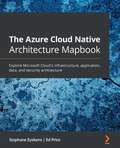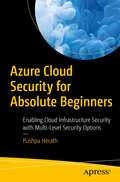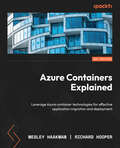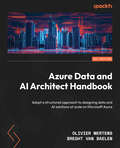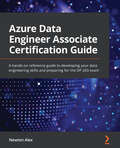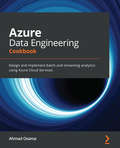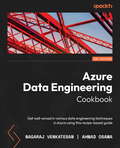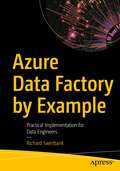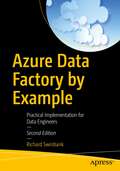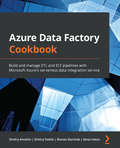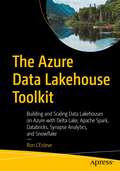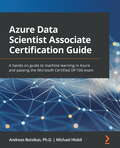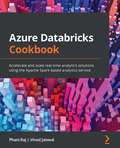- Table View
- List View
The Aztecs, Maya, and their Predecessors: Archaeology of Mesoamerica, Third Edition
by Muriel Porter WeaverThe Third Edition of this highly successful introduction to the archaeology of Mesoamerica includes full coverage of the Aztec and Maya areas in one volume. Beginning with the settling of the New World and continuing through the Spanish conquest of Mesoamerica in 1521, this completely updated textbook includes the deciphering of Maya hieroglyphs, the dynamic history of the Maya, the new royal tomb excavated at Copan, Honduras, important new discoveries at Rio Azul and Naj Tunich in Guatemala, and Caracol in Belize, ritual sacrifices on a massive scale revealed at Teotihuacan in central Mexico, and new material from Tula (Toltec capitol) and from the heart of Mexico City.
Azure Active Directory For Secure Application Development: Use Modern Authentication Techniques To Secure Applications In Azure
by Sjoukje ZaalUse modern authentication techniques to secure applications in Azure
Azure and Xamarin Forms: Cross Platform Mobile Development
by Russell FustinoDiscover how to create cross platform apps for Android, iOS and UWP using Azure services and C# with Xamarin Forms. This book illustrates how to utilize Azure cloud storage for serving up Azure SQL DB data through Azure App Services.The book starts by setting up Xamarin and introducing Xamarin Forms and then covers the Azure Portal from a developer’s perspective and goes on to demonstrate how to build an Azure Service using Quickstart. You'll also see how to add Azure support to Xamarin Forms application. You'll review in detail how to build a Xamarin Form with Azure Client and modify an existing app to become a Xamarin Forms Client for Azure with offline synchronization.You then move on to third-party controls that speed up development. By the end of the book, you will be able to use Azure and Xamarin together and master how to use Azure Mobile Quickstarts, Azure SQL plumbing, database synchronization and Xamarin Forms.What You'll LearnCreate a Xamarin Forms App and understand the Structure of a Xamarin Forms App. Navigate pages and use platform specific coding. Use images, ListView and the Azure Mobile App Quickstart to build a Service and Xamarin Forms appModify an existing app to use Azure Client Libraries, understand offline storage with SQLite and incorporate offline synchronizationWho This Book Is For Software developers new to Xamarin and/or Azure and for the developers who are familiar with both the technologies to use in mobile apps.
Azure Arc-Enabled Data Services Revealed: Early First Edition Based on Public Preview
by Ben Weissman Anthony E. NocentinoGet introduced to Azure Arc-enabled data services and the powerful capabilities they provide to deploy and manage local, on-premises, and hybrid cloud data resources using the same centralized management and tooling you get from the Azure cloud. This book shows how you can deploy and manage databases running on SQL Server and Posgres in your corporate data center as if they were part of the Azure platform. You will learn how to benefit from the centralized management that Azure provides, the automated rollout of patches and updates, and more. This book is the perfect choice for anyone looking for a hybrid or multi-vendor cloud strategy for their data estate. The authors walk you through the possibilities and requirements to get services such as Azure SQL Managed Instance and PostgresSQL Hyperscale, deployed outside of Azure, so the services are accessible to companies that cannot move to the cloud or do not want to use the Microsoft cloud exclusively. The technology described in this book will be especially useful to those required to keep sensitive services, such as medical databases, away from the public cloud, but who still want to benefit from the Azure cloud and the centralized management and tooling that it supports.What You Will LearnUnderstand the core concepts of KubernetesUnderstand the fundamentals and architecture of Azure Arc-enabled data servicesBuild a multi-cloud strategy based on Azure data servicesDeploy Azure Arc-enabled data services on premises or in any cloudDeploy Azure Arc-enabled SQL Managed Instance on premises or in any cloudDeploy Azure Arc-enabled PostgreSQL Hyperscale on premises or in any cloudManage Azure-enabled data services running outside of AzureMonitor Azure-enabled data services running outside of Azure through the Azure Portal Who This Book Is ForDatabase administrators and architects who want to manage on-premises or hybrid cloud data resources from the Microsoft Azure cloud. Especially for those wishing to take advantage of cloud technologies while keeping sensitive data on premises and under physical control.
Azure Arc-enabled Data Services Revealed: Deploying Azure Data Services on Any Infrastructure
by Ben Weissman Anthony E. NocentinoGet introduced to Azure Arc-enabled Data Services and the powerful capabilities to deploy and manage local, on-premises, and hybrid cloud data resources using the same centralized management and tooling you get from the Azure cloud. This book shows how you can deploy and manage databases running on SQL Server and Postgres in your corporate data center or any cloud as if they were part of the Azure platform. This second edition has been updated to the latest codebase, allowing you to use this book as your handbook to get started with Azure Arc-enabled Data Services today. Learn how to benefit from Azure's centralized management, the automated rollout of patches and updates, managed backups, and more. This book is the perfect choice for anyone looking for a hybrid or multi-vendor cloud strategy for their data estate. The authors walk you through the possibilities and requirements to get Azure SQL Managed Instance and PostgresSQL Hyperscale deployed outside of Azure, so the services are accessible to companies that cannot move to the cloud or do not want to use the Microsoft cloud exclusively. The technology described in this book will benefit those required to keep sensitive services, such as medical databases, away from the public cloud equally as those who can’t move to a public cloud for other reasons such as infrastructure constraints but still want to benefit from the Azure cloud and the centralized management and tooling that it supports.What You Will LearnUnderstand the fundamentals and architecture of Azure Arc-enabled data servicesBuild a multi-cloud strategy based on Azure Data ServicesDeploy Azure Arc-enabled data services on premises or in any cloudDeploy Azure Arc-enabled SQL Managed Instance on premises or in any cloudDeploy Azure Arc-enabled PostgreSQL Hyperscale on premises or in any cloudBackup and Restore your data that is managed by Azure Arc-enabled data servicesManage Azure-enabled data services running outside of AzureMonitor Azure-enabled data services through Grafana and KibanaMonitor Azure-enabled data services running outside of Azure through Azure MonitorWho This Book Is ForDatabase administrators and architects who want to manage on-premises or hybrid cloud data resources from the Microsoft Azure cloud. Especially for those wishing to take advantage of cloud technologies while keeping sensitive data on premises and under physical control.
Azure Arc-Enabled Kubernetes and Servers: Extending Hyperscale Cloud Management to Your Datacenter
by Steve Buchanan John JoynerWelcome to this introductory guide to using Microsoft’s Azure Arc service, a new multi-cloud management platform that belongs in every cloud or DevOps estate. As many IT pros know, servers and Azure Kubernetes Service drive a huge amount of consumption in Azure—so why not extend familiar management tools proven in Azure to on-premises and other cloud networks? This practical guide will get you up to speed quickly, with instruction that treads light on the theory and heavy on the hands-on experience to make setting up Azure Arc servers and Kubernetes across multiple clouds a lot less complex. Azure experts and MVPs Buchanan and Joyner provide just the right amount of context so you can grasp important concepts, and get right to the business of using and gaining value from Azure Arc. If your organization has resources across hybrid cloud, multi-cloud, and edge environments, then this book is for you. You will learn how to configure and use Azure Arc to uniformly manage workloads across all of these environments. What You Will Learn Introduces the basics of hybrid, multi-cloud, and edge computing and how Azure Arc fits into that IT strategyTeaches the fundamentals of Azure Resource Manager, setting the reader up with the knowledge needed on the technology that underpins Azure ArcOffers insights into Azure native management tooling for managing on-premises servers and extending to other clouds Details an end-to-end hybrid server monitoring scenario leveraging Azure Monitor and/or Azure Sentinel that is seamlessly delivered by Azure Arc Defines a blueprint to achieve regulatory compliance with industry standards using Azure Arc, delivering Azure Policy from Azure Defender for Servers Explores how Git and GitHub integrate with Azure Arc; delves into how GitOps is used with Azure ArcEmpowers your DevOps teams to perform tasks that typically fall under IT operationsDives into how to best use Azure CLI with Azure Arc Who This Book Is ForDevOps, system administrators, security professionals, and IT workers responsible for servers both on-premises and in the cloud. Some experience in system administration, DevOps, containers, and use of Git/GitHub is helpful.
Azure Arc Systems Management: Governance and Administration of Multi-cloud and Hybrid IT Estates
by Ramona MaxwellThis book is for enterprise and solution architects, systems integrators, and anyone managing enterprise-scale, multi-cloud or hybrid IT landscapes. The book examines usage of Azure Arc for governance and systems management with security as an overarching theme. It is not an implementation manual but provides high-level guidance on best practices and links to detailed guidance. It offers insight into the types of problems that Azure Arc can solve, and will help you determine whether it is the right choice for your organization.Modern enterprise computing is an astonishing luxury land filled with never-before-seen hosting options on commercial clouds as well as advancements in the areas of private cloud and edge computing. The challenge with this plethora of choices is to manage and coordinate large IT estates which may bridge multiple public clouds and private datacenters. Visibility of operations to achieve security, cost control, and efficiency is often difficult to achieve. Data management is another area which is particularly fraught with complexity and risk.Industry leaders have made serious investments in the design of control plane products to address these gaps with varying approaches and degrees of success. Azure Arc is designed to provide a consolidated view of assets such as databases and Kubernetes installations across major cloud providers, edge locations, and customer-owned datacenters. It facilitates deployment of new infrastructure, patching and upgrades, monitoring, policy, and security controls for assets living on-premises or in competitor clouds as if they were native to Azure. While competitive products exist, at this writing none have the flexibility and reach of Arc to effectively manage very large hybrid estates.Readers will appreciate the author’s approach of walking through typical enterprise computing scenarios while listing industry- or scenario-specific challenges that are difficult to overcome, and then reinforcing understanding by restating the challenges while explaining how Azure Arc can be utilized to remediate them.What You Will LearnDiscover what Azure Arc is, the types of problems it is intended to solve, and how to map your requirements to its capabilitiesStreamline and secure large Arc-enabled Kubernetes deployments via modern GitOps practicesUse Azure Arc to consolidate management across a broad range of hybrid and multi-cloud ecosystems through policy-driven governanceApply monitoring and automation to defend systems against security threats that are beyond the ability of manual administration to deflectUncover practical guidance that is written in a way that makes basic precepts approachable to non-technical stakeholders and then branches out into areas that will offer advanced readers new insights and consolidate a broad topic into a usable directionWho This BookIs ForEnterprise and solution architects, systems integrators, and anyone else looking to solve enterprise-scale administration problems across a multi-cloud or hybrid architecture
Azure Architecture Explained: A comprehensive guide to building effective cloud solutions
by David Rendón Brett HargreavesEnhance your career as an Azure architect with cutting-edge tools, expert guidance, and resources from industry leadersKey FeaturesDevelop your business case for the cloud with technical guidance from industry expertsAddress critical business challenges effectively by leveraging proven combinations of Azure servicesTackle real-world scenarios by applying practical knowledge of reference architecturesPurchase of the print or Kindle book includes a free PDF eBookBook DescriptionAzure is a sophisticated technology that requires a detailed understanding to reap its full potential and employ its advanced features. This book provides you with a clear path to designing optimal cloud-based solutions in Azure, by delving into the platform's intricacies. You’ll begin by understanding the effective and efficient security management and operation techniques in Azure to implement the appropriate configurations in Microsoft Entra ID. Next, you’ll explore how to modernize your applications for the cloud, examining the different computation and storage options, as well as using Azure data solutions to help migrate and monitor workloads. You’ll also find out how to build your solutions, including containers, networking components, security principles, governance, and advanced observability. With practical examples and step-by-step instructions, you’ll be empowered to work on infrastructure-as-code to effectively deploy and manage resources in your environment. By the end of this book, you’ll be well-equipped to navigate the world of cloud computing confidently.What you will learnImplement and monitor cloud ecosystem including, computing, storage, networking, and securityRecommend optimal services for performance and scaleProvide, monitor, and adjust capacity for optimal resultsCraft custom Azure solution architecturesDesign computation, networking, storage, and security aspects in AzureImplement and maintain Azure resources effectivelyWho this book is forThis book is an indispensable resource for Azure architects looking to develop cloud-based services along with deploying and managing applications within the Microsoft Azure ecosystem. It caters to professionals responsible for crucial IT operations, encompassing budgeting, business continuity, governance, identity management, networking, security, and automation. If you have prior experience in operating systems, virtualization, infrastructure, storage structures, or networking, and aspire to master the implementation of best practices in the Azure cloud, then this book will become your go-to guide.
Azure Automation Using the ARM Model: An In-Depth Guide to Automation with Azure Resource Manager
by Shijimol Ambi KarthikeyanFocus exclusively on the Azure Resource Manager (ARM) deployment model for Azure automation and gain in-depth knowledge of topics such as runbook authoring, different types of automation runbooks, and hybrid cloud automation. This book covers practical approaches to creating runbooks for multiple use cases, including operational tasks such as VM management and integration of Azure automation with infrastructure monitoring solutions, such as Operations Management Suite (OMS). Along the way you’ll see how to use PowerShell in Azure automation and cover essentials including Azure automation security, source control integration, and runbook output streams. Finally, you learn about integrating Azure automation with Desired State Configuration (DSC) to include various cloud, on-premise, and hybrid scenarios. What You Will Learn · Work with the building blocks of Azure automation · Create different types of runbook · Master hybrid cloud automation with ARM · Implement cloud automation use cases with practical examples Who This Book Is For Infrastructure and cloud architects, cloud support engineers, and system administrators.
Azure Cloud Adoption Framework Handbook: A Comprehensive Guide To Adopting And Governing The Cloud For Your Digital Transformation
by Sasa Kovacevic Darren DempseyA comprehensive guide to adopting and governing the cloud for your digital transformation
The Azure Cloud Native Architecture Mapbook: Explore Microsoft Cloud's infrastructure, application, data, and security architecture
by Ed Price Stephane EyskensImprove your Azure architecture practice and set out on a cloud and cloud-native journey with this Azure cloud native architecture guideKey FeaturesDiscover the key drivers of successful Azure architectureImplement architecture maps as a compass to tackle any challengeUnderstand architecture maps in detail with the help of practical use casesBook DescriptionAzure offers a wide range of services that enable a million ways to architect your solutions. Complete with original maps and expert analysis, this book will help you to explore Azure and choose the best solutions for your unique requirements. Starting with the key aspects of architecture, this book shows you how to map different architectural perspectives and covers a variety of use cases for each architectural discipline. You'll get acquainted with the basic cloud vocabulary and learn which strategic aspects to consider for a successful cloud journey. As you advance through the chapters, you'll understand technical considerations from the perspective of a solutions architect. You'll then explore infrastructure aspects, such as network, disaster recovery, and high availability, and leverage Infrastructure as Code (IaC) through ARM templates, Bicep, and Terraform. The book also guides you through cloud design patterns, distributed architecture, and ecosystem solutions, such as Dapr, from an application architect's perspective. You'll work with both traditional (ETL and OLAP) and modern data practices (big data and advanced analytics) in the cloud and finally get to grips with cloud native security. By the end of this book, you'll have picked up best practices and more rounded knowledge of the different architectural perspectives.What you will learnGain overarching architectural knowledge of the Microsoft Azure cloud platformExplore the possibilities of building a full Azure solution by considering different architectural perspectivesImplement best practices for architecting and deploying Azure infrastructureReview different patterns for building a distributed application with ecosystem frameworks and solutionsGet to grips with cloud-native concepts using containerized workloadsWork with AKS (Azure Kubernetes Service) and use it with service mesh technologies to design a microservices hosting platformWho this book is forThis book is for aspiring Azure Architects or anyone who specializes in security, infrastructure, data, and application architecture. If you are a developer or infrastructure engineer looking to enhance your Azure knowledge, you'll find this book useful.
Azure Cloud Security for Absolute Beginners: Enabling Cloud Infrastructure Security with Multi-Level Security Options
by Pushpa HerathImplement cloud security with Azure security tools, configurations and policies that address the needs of businesses and governments alike. This book introduces you to the most important security solutions available in Azure and provides you with step-by-step guidance to effectively set up security and deploy an application on top of Azure platform services, as well as on top of Azure infrastructure. Author Pushpa Herath begins by teaching you the fundamentals of Azure security. An easy to follow exploration of management groups, subscriptions, management locks and Azure policies further elaborate the concepts underlying Azure cloud security. Next, you will learn about Azure Active Directory (AAD) and the utilization of AAD in application and infrastructure security. Essential aspects of maintaining secure application keys and certificates are further explained in the context of Azure Key Vault. New application security implementations such as Azure configurations and Azure Defender for Azure storage are discussed, as are key platform security factors. Network security groups, gateways, load balancers, virtual networks and firewall configurations are all demonstrated in detail. Finally, you’ll learn how to create a much more secure environment through Azure App Service Environment in the context of securing infrastructure. If you want to learn the basics of securing Azure, Azure Cloud Security for Absolute Beginners is for you. After reading the book, you will be able to begin implementing secure cloud solutions with Microsoft Azure. What Will You Learn Get up and running quickly securing AzureMaster the basic language of Azure securityUnderstand the security features available in Azure cloudConfigure and maintain Azure cloud security featuresSecure Azure PaaS ServicesLearn identity and access management options in Azure Cloud Who Is This Book For Cloud engineers, DevOps engineers, software developers and architects who are asked to manage or are involved in the Azure infrastructure management but have not had all that much experience with security.
Azure Containers Explained: Leverage Azure Container Technologies For Effective Application Migration And Deployment
by Wesley Haakman and Richard HooperLeverage Azure container technologies for effective application migration and deployment
Azure Data And Ai Architect Handbook: Adopt A Structured Approach To Designing Data And Ai Solutions At Scale On Microsoft Azure
by Olivier Mertens Breght Van BaelenAzure Data and AI Architect Handbook: Adopt A Structured Approach To Designing Data And Ai Solutions At Scale On Microsoft Azure
by Olivier Mertens, Breght Van BaelenAdopt a structured approach to designing data and AI solutions at scale on Microsoft Azure
Azure Data Engineer Associate Certification Guide: A Hands-on Reference Guide To Developing Your Data Engineering Skills And Preparing For The Dp-203 Exam (pdf)
by Newton AlexBecome well-versed with data engineering concepts and exam objectives to achieve Azure Data Engineer Associate certification Key Features Understand and apply data engineering concepts to real-world problems and prepare for the DP-203 certification exam Explore the various Azure services for building end-to-end data solutions Gain a solid understanding of building secure and sustainable data solutions using Azure services Book Description Azure is one of the leading cloud providers in the world, providing numerous services for data hosting and data processing. Most of the companies today are either cloud-native or are migrating to the cloud much faster than ever. This has led to an explosion of data engineering jobs, with aspiring and experienced data engineers trying to outshine each other. Gaining the DP-203: Azure Data Engineer Associate certification is a sure-fire way of showing future employers that you have what it takes to become an Azure Data Engineer. This book will help you prepare for the DP-203 examination in a structured way, covering all the topics specified in the syllabus with detailed explanations and exam tips. The book starts by covering the fundamentals of Azure, and then takes the example of a hypothetical company and walks you through the various stages of building data engineering solutions. Throughout the chapters, you'll learn about the various Azure components involved in building the data systems and will explore them using a wide range of real-world use cases. Finally, you'll work on sample questions and answers to familiarize yourself with the pattern of the exam. By the end of this Azure book, you'll have gained the confidence you need to pass the DP-203 exam with ease and land your dream job in data engineering. What you will learn Gain intermediate-level knowledge of Azure the data infrastructure Design and implement data lake solutions with batch and stream pipelines Identify the partition strategies available in Azure storage technologies Implement different table geometries in Azure Synapse Analytics Use the transformations available in T-SQL, Spark, and Azure Data Factory Use Azure Databricks or Synapse Spark to process data using Notebooks Design security using RBAC, ACL, encryption, data masking, and more Monitor and optimize data pipelines with debugging tips Who this book is for This book is for data engineers who want to take the DP-203: Azure Data Engineer Associate exam and are looking to gain in-depth knowledge of the Azure cloud stack. The book will also help engineers and product managers who are new to Azure or interviewing with companies working on Azure technologies, to get hands-on experience of Azure data technologies. A basic understanding of cloud technologies, extract, transform, and load (ETL), and databases will help you get the most out of this book. Table of Contents Introducing Azure Basics Designing a Data Storage Structure Designing a Partition Strategy Designing the Serving Layer Implementing Physical Data Storage Structures Implementing Logical Data Structures Implementing the Serving Layer Ingesting and Transforming Data Designing and Developing a Batch Processing Solution Designing and Developing a Stream Processing Solution Managing Batches and Pipelines Designing Security for Data Policies and Standards Monitoring Data Storage and Data Processing Optimizing and Troubleshooting Data Storage and Data Processing Sample Questions with Solutions
Azure Data Engineering Cookbook: Design And Implement Batch And Streaming Analytics Using Azure Cloud Services
by Ahmad OsamaDesign and implement batch and streaming analytics using Azure Cloud Services
Azure Data Engineering Cookbook: Get Well Versed In Various Data Engineering Techniques In Azure Using This Recipe-based Guide
by Nagaraj Venkatesan Ahmad OsamaAzure Data Factory by Example: Practical Implementation for Data Engineers
by Richard SwinbankData engineers who need to hit the ground running will use this book to build skills in Azure Data Factory v2 (ADF). The tutorial-first approach to ADF taken in this book gets you working from the first chapter, explaining key ideas naturally as you encounter them. From creating your first data factory to building complex, metadata-driven nested pipelines, the book guides you through essential concepts in Microsoft’s cloud-based ETL/ELT platform. It introduces components indispensable for the movement and transformation of data in the cloud. Then it demonstrates the tools necessary to orchestrate, monitor, and manage those components.The hands-on introduction to ADF found in this book is equally well-suited to data engineers embracing their first ETL/ELT toolset as it is to seasoned veterans of Microsoft’s SQL Server Integration Services (SSIS). The example-driven approach leads you through ADF pipeline construction from the ground up, introducing important ideas and making learning natural and engaging. SSIS users will find concepts with familiar parallels, while ADF-first readers will quickly master those concepts through the book’s steady building up of knowledge in successive chapters. Summaries of key concepts at the end of each chapter provide a ready reference that you can return to again and again.What You Will LearnCreate pipelines, activities, datasets, and linked servicesBuild reusable components using variables, parameters, and expressionsMove data into and around Azure services automaticallyTransform data natively using ADF data flows and Power Query data wranglingMaster flow-of-control and triggers for tightly orchestrated pipeline executionPublish and monitor pipelines easily and with confidenceWho This Book Is ForData engineers and ETL developers taking their first steps in Azure Data Factory, SQL Server Integration Services users making the transition toward doing ETL in Microsoft’s Azure cloud, and SQL Server database administrators involved in data warehousing and ETL operations
Azure Data Factory Cookbook: Build and manage ETL and ELT pipelines with Microsoft Azure's serverless data integration service
by Dmitry Anoshin Dmitry Foshin Roman Storchak Xenia IretonSolve real-world data problems and create data-driven workflows for easy data movement and processing at scale with Azure Data FactoryKey FeaturesLearn how to load and transform data from various sources, both on-premises and on cloudUse Azure Data Factory's visual environment to build and manage hybrid ETL pipelinesDiscover how to prepare, transform, process, and enrich data to generate key insightsBook DescriptionAzure Data Factory (ADF) is a modern data integration tool available on Microsoft Azure. This Azure Data Factory Cookbook helps you get up and running by showing you how to create and execute your first job in ADF. You'll learn how to branch and chain activities, create custom activities, and schedule pipelines. This book will help you to discover the benefits of cloud data warehousing, Azure Synapse Analytics, and Azure Data Lake Gen2 Storage, which are frequently used for big data analytics. With practical recipes, you'll learn how to actively engage with analytical tools from Azure Data Services and leverage your on-premise infrastructure with cloud-native tools to get relevant business insights. As you advance, you'll be able to integrate the most commonly used Azure Services into ADF and understand how Azure services can be useful in designing ETL pipelines. The book will take you through the common errors that you may encounter while working with ADF and show you how to use the Azure portal to monitor pipelines. You'll also understand error messages and resolve problems in connectors and data flows with the debugging capabilities of ADF. By the end of this book, you'll be able to use ADF as the main ETL and orchestration tool for your data warehouse or data platform projects.What you will learnCreate an orchestration and transformation job in ADFDevelop, execute, and monitor data flows using Azure SynapseCreate big data pipelines using Azure Data Lake and ADFBuild a machine learning app with Apache Spark and ADFMigrate on-premises SSIS jobs to ADFIntegrate ADF with commonly used Azure services such as Azure ML, Azure Logic Apps, and Azure FunctionsRun big data compute jobs within HDInsight and Azure DatabricksCopy data from AWS S3 and Google Cloud Storage to Azure Storage using ADF's built-in connectorsWho this book is forThis book is for ETL developers, data warehouse and ETL architects, software professionals, and anyone who wants to learn about the common and not-so-common challenges faced while developing traditional and hybrid ETL solutions using Microsoft's Azure Data Factory. You'll also find this book useful if you are looking for recipes to improve or enhance your existing ETL pipelines. Basic knowledge of data warehousing is expected.
Azure Data Factory Cookbook: Build ETL, Hybrid ETL, and ELT pipelines using ADF, Synapse Analytics, Fabric and Databricks
by Dmitry Foshin Tonya Chernyshova Dmitry Anoshin Xenia IretonData Engineers guide to solve real-world problems encountered while building and transforming data pipelines using Azure's data integration toolKey FeaturesSolve real-world data problems and create data-driven workflows with ease using Azure Data FactoryBuild an ADF pipeline that operates on pre-built ML model and Azure AIGet up and running with Fabric Data Explorer and extend ADF with Logic Apps and Azure functionsBook DescriptionThis new edition of the Azure Data Factory book, fully updated to reflect ADS V2, will help you get up and running by showing you how to create and execute your first job in ADF. There are updated and new recipes throughout the book based on developments happening in Azure Synapse, Deployment with Azure DevOps, and Azure Purview. The current edition also runs you through Fabric Data Factory, Data Explorer, and some industry-grade best practices with specific chapters on each. You’ll learn how to branch and chain activities, create custom activities, and schedule pipelines, as well as discover the benefits of cloud data warehousing, Azure Synapse Analytics, and Azure Data Lake Gen2 Storage. With practical recipes, you’ll learn how to actively engage with analytical tools from Azure Data Services and leverage your on-premises infrastructure with cloud-native tools to get relevant business insights. You'll familiarize yourself with the common errors that you may encounter while working with ADF and find out the solutions to them. You’ll also understand error messages and resolve problems in connectors and data flows with the debugging capabilities of ADF. By the end of this book, you’ll be able to use ADF with its latest advancements as the main ETL and orchestration tool for your data warehouse projects.What you will learnBuild and Manage data pipelines with ease using the latest version of ADFConfigure, load data, and operate data flows with Azure SynapseGet up and running with Fabric Data FactoryWorking with Azure Data Factory and Azure PurviewCreate big data pipelines using Databricks and Delta tablesIntegrate ADF with commonly used Azure services such as Azure ML, Azure Logic Apps, and Azure FunctionsLearn industry-grade best practices for using Azure Data FactoryWho this book is forThis book is for ETL developers, data warehouse and ETL architects, software professionals, and anyone else who wants to learn about the common and not-so-common challenges faced while developing traditional and hybrid ETL solutions using Microsoft's Azure Data Factory. You’ll also find this book useful if you are looking for recipes to improve or enhance your existing ETL pipelines. Basic knowledge of data warehousing is a prerequisite.
The Azure Data Lakehouse Toolkit: Building and Scaling Data Lakehouses on Azure with Delta Lake, Apache Spark, Databricks, Synapse Analytics, and Snowflake
by Ron L'EsteveDesign and implement a modern data lakehouse on the Azure Data Platform using Delta Lake, Apache Spark, Azure Databricks, Azure Synapse Analytics, and Snowflake. This book teaches you the intricate details of the Data Lakehouse Paradigm and how to efficiently design a cloud-based data lakehouse using highly performant and cutting-edge Apache Spark capabilities using Azure Databricks, Azure Synapse Analytics, and Snowflake. You will learn to write efficient PySpark code for batch and streaming ELT jobs on Azure. And you will follow along with practical, scenario-based examples showing how to apply the capabilities of Delta Lake and Apache Spark to optimize performance, and secure, share, and manage a high volume, high velocity, and high variety of data in your lakehouse with ease.The patterns of success that you acquire from reading this book will help you hone your skills to build high-performing and scalable ACID-compliant lakehouses using flexible and cost-efficient decoupled storage and compute capabilities. Extensive coverage of Delta Lake ensures that you are aware of and can benefit from all that this new, open source storage layer can offer. In addition to the deep examples on Databricks in the book, there is coverage of alternative platforms such as Synapse Analytics and Snowflake so that you can make the right platform choice for your needs.After reading this book, you will be able to implement Delta Lake capabilities, including Schema Evolution, Change Feed, Live Tables, Sharing, and Clones to enable better business intelligence and advanced analytics on your data within the Azure Data Platform.What You Will LearnImplement the Data Lakehouse Paradigm on Microsoft’s Azure cloud platformBenefit from the new Delta Lake open-source storage layer for data lakehouses Take advantage of schema evolution, change feeds, live tables, and moreWrite functional PySpark code for data lakehouse ELT jobsOptimize Apache Spark performance through partitioning, indexing, and other tuning optionsChoose between alternatives such as Databricks, Synapse Analytics, and SnowflakeWho This Book Is ForData, analytics, and AI professionals at all levels, including data architect and data engineer practitioners. Also for data professionals seeking patterns of success by which to remain relevant as they learn to build scalable data lakehouses for their organizations and customers who are migrating into the modern Azure Data Platform.
Azure Data Scientist Associate Certification Guide: A Hands-on Guide To Developing Machine Learning Skills And Passing The Microsoft Certified Dp-100 Exam
by Andreas Botsikas, Ph.D. and Michael HlobilA hands-on guide to machine learning in Azure and passing the Microsoft Certified DP-100 exam
Azure Databricks Cookbook (PDF): Accelerate And Scale Real-time Analytics Solutions Using The Apache Spark-based Analytics Service
by Phani Raj Vinod JaiswalGet to grips with building and productionizing end-to-end big data solutions in Azure and learn best practices for working with large datasets Key Features Integrate with Azure Synapse Analytics, Cosmos DB, and Azure HDInsight Kafka Cluster to scale and analyze your projects and build pipelines Use Databricks SQL to run ad hoc queries on your data lake and create dashboards Productionize a solution using CI/CD for deploying notebooks and Azure Databricks Service to various environments Book Description Azure Databricks is a unified collaborative platform for performing scalable analytics in an interactive environment. The Azure Databricks Cookbook provides recipes to get hands-on with the analytics process, including ingesting data from various batch and streaming sources and building a modern data warehouse. The book starts by teaching you how to create an Azure Databricks instance within the Azure portal, Azure CLI, and ARM templates. You'll work through clusters in Databricks and explore recipes for ingesting data from sources, including files, databases, and streaming sources such as Apache Kafka and EventHub. The book will help you explore all the features supported by Azure Databricks for building powerful end-to-end data pipelines. You'll also find out how to build a modern data warehouse by using Delta tables and Azure Synapse Analytics. Later, you'll learn how to write ad hoc queries and extract meaningful insights from the data lake by creating visualizations and dashboards with Databricks SQL. Finally, you'll deploy and productionize a data pipeline as well as deploy notebooks and Azure Databricks service using continuous integration and continuous delivery (CI/CD). By the end of this Azure book, you'll be able to use Azure Databricks to streamline different processes involved in building data-driven apps. What you will learn Read and write data from and to various Azure resources and file formats Build a modern data warehouse with Delta Tables and Azure Synapse Analytics Explore jobs, stages, and tasks and see how Spark lazy evaluation works Handle concurrent transactions and learn performance optimization in Delta tables Learn Databricks SQL and create real-time dashboards in Databricks SQL Integrate Azure DevOps for version control, deploying, and productionizing solutions with CI/CD pipelines Discover how to use RBAC and ACLs to restrict data access Build end-to-end data processing pipeline for near real-time data analytics Who this book is for This recipe-based book is for data scientists, data engineers, big data professionals, and machine learning engineers who want to perform data analytics on their applications. Prior experience of working with Apache Spark and Azure is necessary to get the most out of this book.
